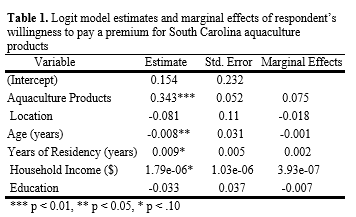CONSUMER’S WILLINGNESS TO PAY FOR ATTRIBUTES OF LOCALITY AND SUSTAINABILITY OF SOUTH CAROLINA AQUACULTURE PRODUCTS
Evaluating the effect of attributes used in seafood labelling schemes has relied on empirical evidence from consumers' preferences . Attributes of interest in the case of this study are locality and sustainability , whether the seafood is a product of South Carolina, or any other state and whether the products display ecolabels from the Marine Stewardship Council (MSC) or Aquaculture Stewardship Council (ASC).
Consumers who have previously purchased aquaculture products, regardless of the source, on average are 7.5% more likely to be willing to pay a premium for aquaculture products from South Carolina, while older consumers are less likely willing to pay a premium for local aquaculture products. Using the results of this logit model, we included only main attributes of source and method in the WTP estimates.
Residents of South Carolina (N=1,947) were surveyed on their preferences and perceptions towards South Carolina aquaculture products in order to estimate th eir willingness to pay (WTP) for locally and sustainably produce. Table 1 shows the explanatory variables that affect a respondent's likelihood that they are willing to pay a premium for local aquaculture products.
We estimated consumers' WTP a premium for local oysters , clams and shrimp per pound and if labeling (Aquaculture Stewardship Council (ASC)) affect consumers' WTP . Table 2 shows that across all models, local shellfish products are valued higher than non-local products, and in the case of oysters, locally grown oysters (lbs.) are valued higher than non-local wild-caught oysters.

